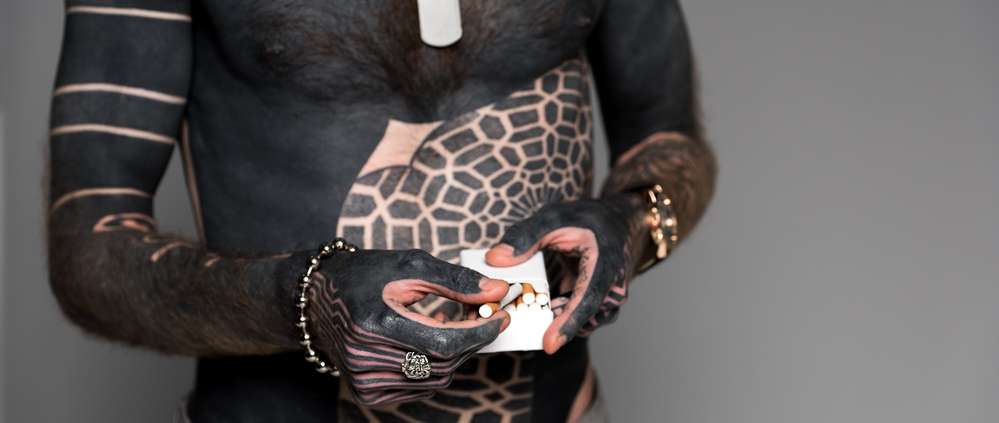What Are Blackwork Tattoos?
You want a tattoo that is bold but not overdone. One of the best options for you is a blackwork tattoo. Not to be confused with a blackout tattoo, a blackwork tattoo describes tattoos that are made up of only black pigment. There are many kinds of blackwork tattoos out there, including tribal designs. If you think a blackwork tattoo is right for you, here are some of the things you need to know before sitting down with a professional tattoo artist.
What is Blackwork?
Blackwork tattoos are relatively simple to explain, because it is what you assume it would be: black ink. There is an overlap of different styles in blackwork—tribal, contemporary, and more. Historically speaking, blackwork is associated with the ink work of ancient tribes, like the Polynesians. Blackwork is a tradition with thousands of years of history. Let’s break some of it down:
Mesoamerican Origins of Blackwork
The earliest forms of blackwork can be traced back to the dawning of humankind, when people were first constructing civilizations in Mesoamerica. But there were other traces of tattooing down in Ancient Africa and Egypt. In other words, tattooing of this kind may have been around since 1500 BC.
Polynesian Blackwork Tattoos
Ancient Polynesians used their tattoos as a way to communicate their beliefs, be they religious or philosophy. Social standing, blood lines, and even exploits in battle were recorded on their skin. Tattoos can also be a form of spiritual protection, depending on the individual’s beliefs. As such, the placement and style of the tattoo could tell someone hundreds of things. If you are planning on getting a tribal style blackwork tattoo, keep that in mind!
Spanish Blackwork Tattoos
Characterized by geometric designs, interlocking loops, and intricate patterns, Spanish blackwork has been around since the 16th century. Unlike tribal blackwork, Spanish blackwork does not have any symbolic meaning. It is regarded as body art that is also often used for concealing cosmetic blemishes or disfigurement, such as deep scarring.
But where did Spanish blackwork come from? It is thought that, originally, the patterns were used on silk from textile artists traveling from India. In fact, the patterns are very similar to Kasuti embroidery, which as been around since the 6th century.
Presently, tattoo artists like Ciara Havishya and Clinton Lee are returning Spanish blackwork to its former glory.
Blackwork Goes West
As people began exploring the world, more tattoo styles were discovered. A British explorer, James Cook, is credited with bringing this style to the Western world in 1769. He was fascinated with blackwork and decided to introduce it to Europe. Since then, the blackwork tribal markings became exceedingly popular among coal miners and sailors.
Another person credited with bringing blackwork tattoos to the masses is Leo Zulueta, whose tribal tattoos gained attention in 1989. The term “blackwork” was coined by Casper Mugridge, a tattoo artist at Showdown Tattoo in Alberta, Canada. Interestingly, those artists who work strictly with black ink are known as “blackworkers.”
Key Elements of Blackwork Tattoos
It does not take a keen eye to spot blackwork. Any tattoo design that is made only with black ink can be called “blackwork.” The key element is that blackwork tattoos do not have any other color, not even gray tones to dilute the black.
Furthermore, blackwork tattoos typically feature:
- Crosshatching
- Dot work
- Blocking
- Limited texture
- Negative space designs
Are Blackout and Blackwork Tattoos The Same Thing?
Although “blackout” and “blackwork” are often used interchangeably in some settings, they are describing two different styles. Generally, blacking out a section of the body means to saturate the skin with pigment without any design. Blackout designs also take a lot of body real estate, whereas blackwork tattoos can be a simple flash image on your finger.
In blackwork, the design is the priority. Your artist may utilize some elements of the blackout style, especially if your design features the use of negative space.
Creating a Blackwork Tattoo
When it comes to blackwork tattoos, anything goes! You can go the tribal route, which are usually solid pieces taking up large portions of a limb, your torso, or back.
Geometric designs are creative, innovative, and ideal for blackwork. You can choose something simple or get a complex tessellation that makes for an entire sleeve.
Two other styles for blackwork are dark art and graphic art. The first—dark art—refers to more magical or gothic images, such as alchemical circles, tarot cards, Lovecraftian monsters, and horror. Blackwork adds to the overall ornate yet creepy vibe of these designs. Graphic art is similar, but it looks more like a visual print from a comic book or manga. Since black ink is the only option, you have to choose a tattoo artist who is not only comfortable with black work but also skilled at this kind of artwork.
Lastly, lettering is an excellent choice for blackwork, especially if you want to make a simple but bold statement. Keep in mind that not every calligraphic design is going to look good solely in black. It’s recommended that you discuss your font and image options with your artists to ensure you love the final result.
Considering a Blackwork Tattoo?
With so many options for a blackwork tattoo, you are probably itching to get one—or several. One of the best things about blackwork tattoos is that they look beautiful, despite being a single color. Simple or complex, this is one tattoo style that will never lose its popularity.
Looking to get inked with blackwork? Give Oracle Tattoo Gallery a call or fill out the contact form. Our artists can design a striking piece that will delight you for years to come or we can cover up old ink with stunning tribal blackwork. You can also check out our social media for some inspiration.



